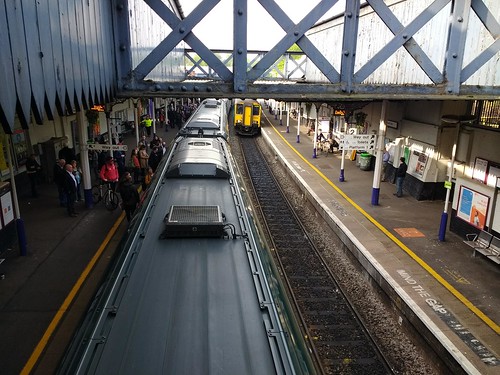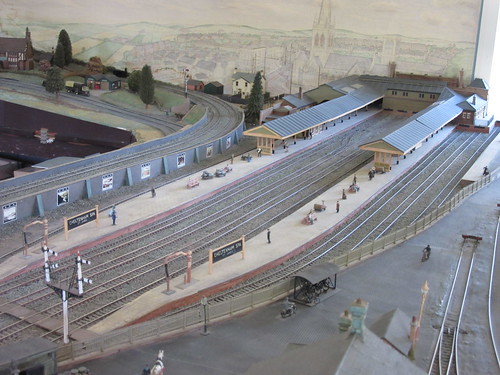| Wolverhampton-Cheltenham-Caldicot | Arrive | Depart |
| Wolverhampton | 07:16 | |
| Cheltenham | 08:24 | 08:46 |
| Caldicot | 10:36 | 11:02 |
My journey started at Wolverhampton, joining a Cross Country service from Manchester to Bristol, reporting number 1V43, as far as Cheltenham. The 'Voyager' was crowded but made good time to Birmingham and continued on the Camp Hill line until the approach to Kings Norton where we had to wait for a Class 323 to cross in front of us from the Bournville Line to the slow line to Bromsgrove.

Kings Norton Station with foliage on disused island platform obscuring an EMU heading for New Street (Caldicot by train).
We had no booked stops and were soon descending the famous Lickey Incline at speed. Suburban 25 kV a.c. electrification now extends as far as Bromsgrove and it still seems strange to me to see Overhead Line Equipment on this stretch. Even odder is the new multi-platform Bromsgrove Station, so different from the previous modest facilities.

Bromsgrove Station, expanded and rebuilt (Caldicot by train).
Just over an hour after leaving Wolverhampton, we slowed on the approach to Cheltenham Spa station. Looking left, I was surprised to see a GWR (that's the modern 'GWR' title adopted by FirstGroup plc) 'bi-mode' Class 800 in green livery waiting on the adjacent line. I left the 'Voyager' and made my way to the footbridge to take in the layout of the two-platform station set in a cutting on a gentle curve. By that time, my 'Voyager' had left and the Class 800 had moved into platform 1, to form the next London service. I didn't take much notice of the Diesel Multiple Unit arriving in platform 2 but afterwards I realised that this was the terminating Transport for Wales service from Maesteg which would form my connection to Caldicot. The line I'd seen the Class 800 waiting on is now a 'turnback siding', and is frequent use bu both GWR and Transport for Wales services.

Cheltenham Spa Station view from footbridge looking towards Bristol, showing GWR 'bi-mode' Class 800 in platform 1 and DMU from Maesteg arriving in platform 2 (Caldicot by train).
I exited through the automatic barriers on the Queen's Road side to briefly explore. The station road approach is at the level of the footbridge so the neat, stuccoed buildings are not particularly impressive.

Cheltenham Spa station building, facing Queen's Road (Caldicot by train).
Cheltenham formerly boasted a number of stations. Perhaps best-known (and most conveniently-located) was the long-gone G.W.R. terminus Cheltenham Spa St. James, starting point of the famous 'Cheltenham Flyer' express. I don't believe I ever visited this station but I remember the road bridge and junctions adjacent to the surviving station which was then called Cheltenham Spa Lansdown. The Queen's Road Bridge is still in use, now carrying the road over an urban cycle track. At 'Lionsmeet 2015', I saw a splendid 4 m.m. scale model of Cheltenham Spa St. James built by the Guildford Model Engineering Society and mentioned in my report here.
 A view of part of the 4mm scale layout of Cheltenham Spa St. James.
A view of part of the 4mm scale layout of Cheltenham Spa St. James.
After my brief excursion outside the station, I caught reporting number 2L49 (Transport for Wales service from Cheltenham to Maesteg) and alighted at Caldicot. It's a leisurely journey, stopping frequently, but not without interest. The first stop is at Gloucester which for a long time had separate Midland and Great Western stations. Closure of the Midland station and its connections meant that Birmingham-Bristol trains then needed to use the triangle from the main line in order to call at the former Great Western station and then change direction. For some years, I remember most Cross Country 'Voyagers' making this detour but changes to the timetable mean that it now may be necessary to change to reach Gloucester. Because of its importance, Gloucester was equipped with a Western Region style power signal box which remains in use.

Gloucester Power Signal Box (Caldicot by train).
Leaving Gloucester, there were good views of the medieval cathedral before the line crossed the River Severn near Over, later turning south west to run close to the broadening River Severn at Newnham.

Gloucester Cathedral (Caldicot by train).

The River Severn near Newnham (Caldicot by train).
Caldicot station is less than 1 kilomtre east of the better-known Severn Tunnel Junction. The double-track route from the Tunnel runs in a cutting just north of Caldicot station and in the picture below, you can just make out, in the distance, the Overhead Line structures on the parallel tunnel route.

Caldicot Station, looking towards Newport (Caldicot by train).
I don't believe I'd visited Caldicot before - it's an interesting, rather modern small town. The two halves of my meeting were divided by a visit to a cafe within walking distance which furnished a very enjoyable all-day breakfast. When the meeting finished, I was driven to Caldicot station to make sure I didn't miss the return service.
The return timings were:-
| Caldicot-Cheltenham-Wolverhampton | Arrive | Depart |
| Caldicot | 15:42 | |
| Cheltenham | 16:31 | 16:41 |
| Wolverhampton | 17:48 |
The return train was reporting number 2G52 which had left Maesteg at 14:15. After off-loading its passengers, the empty stock went through the facing crossover on the main lines and entered the 'turnback siding', under the control of Gloucester signal G45, a 3-aspect colour light with a line-of-lights route indicator reading to the Up Goods Loop when lit. The movement to the turnback siding was authorised by a subsidiary aspect of two diagonal white lights and an illuminated 'S'.

Cheltenham Spa: View from platform 2 showing signal G45 displaying a subsidiary proceed and 'S' allowing the stock from my arrival to cross to the Turnback Siding (Caldicot by train).

Cheltenham Spa Station: View of platform 1 from platform 2 (Caldicot by train).
After a down Cross Country Voyager had paused briefly at platform 1 and noisily deported, the Transport for Wales stock emerged from the turnback siding to form train reporting number 2L65, booked to leave at 16:46 and due in Maesteg at 19:08. Whilst 2L65 was boarding passengers, my own up train, another Cross-Country 'Voyager' arrived in platform 2. I managed to find a seat in the heavily-loaded train so the journey back to Wolverhampton was not too bad, then a taxi returned me home.
Related Posts on other Websites
Cheltenham (Wikipedia). Population around 117,000
Gloucester (Wikipedia). Population around 129,000
Caldicot (Wikipedia). Population around 11,000
Book References
[1] 'Regional History of the Railways of Great Britain: Vol. 11, Thames and Severn' by Rex Christiansen (ISBN: 0715380044)
My pictures
I'm sorry, taking pictures in a modern train often gives poor results. Where necessary, clicking on an image above will display an 'uncropped' view or, alternately, pictures may be selected, viewed or downloaded, in various sizes, from the albums below:-
Caldicot by Train
Gradient Diagrams.
